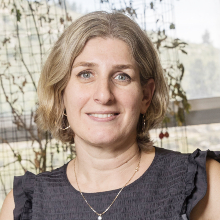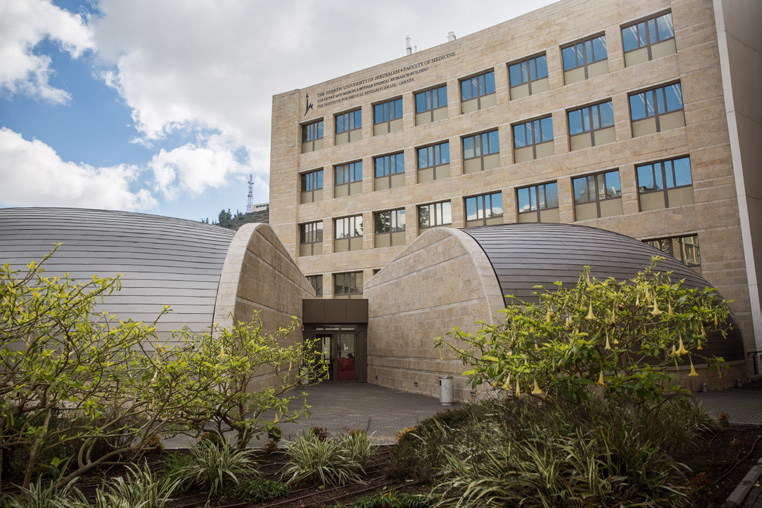
Michal Shoshkes Carmel,Senior Lecturer
Email: michal.shoshkes@mail.huji.ac.il
Tel: +972-2-675-8511
Research Interest:
We use human and mouse intestine as a model to understand the Telocyte in development homeostasis and disease.
Telocytes are large, flat, mesenchymal cells characterized by extremely long cytoplasmic processes, are present in the stroma of almost all organs examined (bone marrow, skin, heart, lung, kidney, intestine, liver, pancreas, brain, reproductive system, bladder, mammary gland, prostate and placenta). Recently, telocytes were demonstrated to constitute the intestinal stem-cell niche by secreting the essential Wnt ligands without which stem-cell renewal is completely ceased.
Intestinal subepithelial telocytes express the surface membrane platelet-derived growth factor receptor a (PDGFRa), while the transcription factor FOXL1 label their nuclei. Telocytes form a continuous comprehensive three dimensional network of contact with the entire intestinal epithelium, from the crypt base to the tip of the villi and compartmentalize transcripts of a wide range of signaling molecules depending upon their position along the crypt-villus axis in correlation to signaling gradients on the epithelium.
Ten Selected Papers:
(1) Bahar Halpern K, Massalha H, Zwick RK, Moor AE, Castillo-Azofeifa D, Rozenberg M, et al. Lgr5+ telocytes are a signaling source at the intestinal villus tip. Nat Commun 2020;11(1).
(2) Shoshkes-Carmel M, Wang YJ, Wangensteen KJ, Tóth B, Kondo A, Massasa EE, et al. Erratum to: Subepithelial telocytes are an important source of Wnts that supports intestinal crypts (Nature, (2018), 557, 7704, (242-246), 10.1038/s41586-018-0084-4). Nature 2018;560(7718):E29.
(3) Shoshkes-Carmel M, Wang YJ, Wangensteen KJ, Tóth B, Kondo A, Massassa EE, et al. Subepithelial telocytes are an important source of Wnts that supports intestinal crypts. Nature 2018;557(7704):242-246.
(4) Dou Z, Ghosh K, Vizioli MG, Zhu J, Sen P, Wangensteen KJ, et al. Cytoplasmic chromatin triggers inflammation in senescence and cancer. Nature 2017;550(7676).
(5) Aoki R, Shoshkes-Carmel M, Gao N, Shin S, May CL, Golson ML, et al. Foxl1-Expressing Mesenchymal Cells Constitute the Intestinal Stem Cell Niche. Cell Mol Gastroenterol Hepatol 2016;2(2):175-188.
(6) Almeida R, Almeida J, Shoshkes M, Mendes N, Mesquita P, Silva E, et al. OCT-1 is over-expressed in intestinal metaplasia and intestinal gastric carcinomas and binds to, but does not transactivate, CDX2 in gastric cells. J Pathol 2005;207(4):396-401.
(7) Ben-Shushan E, Marshak S, Shoshkes M, Cerasi E, Melloul D. A Pancreatic β-Cell-specific Enhancer in the Human PDX-1 Gene Is Regulated by Hepatocyte Nuclear Factor 3β (HNF-3β), HNF-1α, and SPs Transcription Factors. J Biol Chem 2001;276(20):17533-17540.
(8) Marshak S, Ben-Shushan E, Shoshkes M, Havin L, Cerasi E, Melloul D. Regulatory elements involved in human pdx-1 gene expression. Diabetes 2001;50(SUPPL. 1):S37-S38.
(9) Marshak S, Benshushan E, Shoshkes M, Leibovitz G, Kaiser N, Gross D, et al. β-cell-specific expression of insulin and PDX-1 genes. Diabetes 2001;50(SUPPL. 1):S131-S132.
(10) Marshak S, Benshushan E, Shoshkes M, Havin L, Cerasi E, Melloul D. Functional conservation of regulatory elements in the pdx-1 gene: PDX-1 and hepatocyte nuclear factor 3β transcription factors mediate β-cell-specific expression. Mol Cell Biol 2000;20(20):7583-7590.







 Collaborative Investigators
Collaborative Investigators


